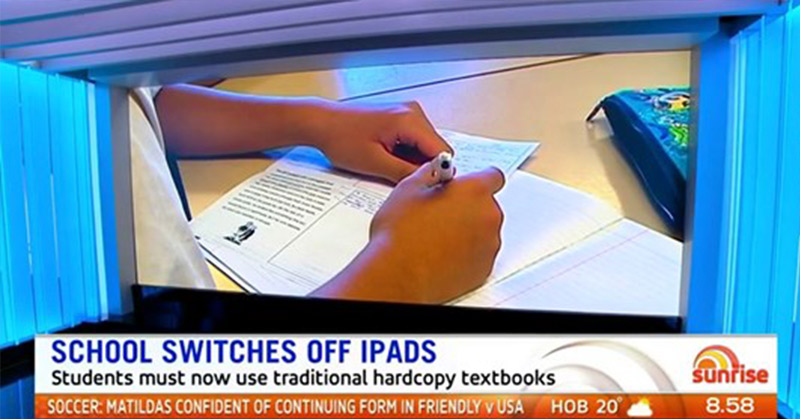This School Banned iPads, Went Back to Regular Textbooks—But What Does the Science Say?
Reddam House Private School in Sydney’s eastern suburbs banned iPads in 2019 and returned to traditional textbooks. The school has implemented a bring-your-own-device policy, with laptops being preferred. For the past five years, Reddam House Private School has used iPads for e-textbooks.
Teachers agree with the decision to prohibit iPads, according to the school, because they were proven to accomplish nothing to improve pupils’ digital abilities and instead hampered study. Parents, on the other hand, had a mixed reaction, with some believing that digital gadgets were necessary for modern teaching.
Principal Dave Pitcairn stated that texts and other notifications on iPads distracted pupils, and that students using hard copy textbooks had a better time studying and taking notes. Pitcairn also feels that when kids look through textbooks, they learn more and employ more senses.
According to the school, the choice was made based on student feedback, who stated that they prefer paper over screens. This shift occurs at a time when an increasing number of students and schools throughout the world are using iPads and other digital devices in the classroom. While this may have occurred in 2019, it is still an issue worth discussing. When does technology unquestionably assist us, and when does it obstruct us? Here’s what the study says regarding whether or not Reddam House made the correct decision.
What Does the Research Say About iPads and Learning?
While there is a lot of study on learning with digital devices, it is far from definitive. The benefits and drawbacks of utilizing iPads in the classroom were emphasized in a study conducted in Canada, where over 6,000 students use iPads every day for studying. Access to knowledge and student motivation were seen as benefits, but distraction and writing skills were cited as drawbacks (apparently, students lacked the ability to type longer papers on the iPad)
Several additional research, including one short study of learning among children with autism spectrum disorder, demonstrated the benefits (more independence) and drawbacks (math skill development) of utilizing iPads in the classroom.
Other long-term research have found that utilizing iPads in the classroom enhances student engagement. Other study, however, asks for additional information, claiming that the educational benefits of using such devices for learning have yet to be properly examined.
Other research and education professionals believe that instructors lack the abilities to really exploit the potential of employing these tools to encourage empowered learning and technological skills among kids, which is maybe not unexpected but a good argument.
Clearly, the evidence for utilizing iPads in the classroom has been mixed, and more specific evidence is needed before we can claim with certainty that using these devices in the classroom is truly benefitting students.
The Case for Using Regular Textbooks Instead of iPads at School
There are a slew of compelling arguments in favor of staying with traditional textbooks. People have pointed out that the changing nature of technology with these gadgets would necessitate updates, which is a major worry as education budgets throughout the world struggle.
Adoption of iPads and other gadgets in the classroom compels schools to create new regulations for these devices in order to manage how they are used, particularly when it comes to internet access.
There’s also data that indicates kids interact better with a real textbook, which contradicts some of the information we mentioned before about the usage of iPads.
Students were shown to read digital print faster, but their understanding was higher while learning from genuine printed textbooks in other research [8]. Other studies show that we still don’t fully comprehend the influence of digital print on children’s learning and understanding.
Given that iPads were just launched in 2010 and integrated into schools during the next several years, I agree that long-term evidence on this significant shift in learning is sorely missing. Perhaps more than anything else, the contradictory studies on iPads and textbooks demonstrates that everything has advantages and disadvantages.
Blue Light, Physical Activity, and Language Development are some of the other factors to consider.
There are, of course, additional factors to consider when it comes to children, iPads, and other electronics that go beyond learning and schools. Children are especially vulnerable to the blue light generated by these gadgets, and research shows that there is cause for worry. When it comes to digital devices, children’s mental health is becoming a significant worry.
According to some experts, using iPads in the classroom and other forms of technology among youngsters might impede language development while also contributing to obesity by pushing the use of digital gadgets over physical exercise, as well as sleep and concentration issues.
Some experts even believe that using digital gadgets in classrooms might cause addiction, melancholy, chronic tension, and irritability. Clearly, more study is needed, as well as possibly even greater apprehension when it comes to utilizing iPads in schools instead of traditional textbooks.
Conclusion
Despite the fact that Reddam House Private School’s decision to prohibit iPads looked to be based on both student and faculty preference for conventional textbooks, it’s possible that they made the correct option by returning to print.
More teacher training looks to be required if iPads are to be utilized to their greatest potential in classrooms, but more evidence is also required to demonstrate that children are benefiting from these gadgets.
Parents who oppose argue that current technology usage is a required ability for most job markets; nevertheless, emphasizing iPad learning does not appear to be the answer—a basic technology course or at-home use of these devices might suffice.










